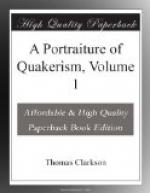In 1647 he extended his travels to Derbyshire, and from thence into Lancashire, but returned to his native county. He met with many friendly people in the course of this journey, and had many serious conversations with them, but he never joined in profession with any. At Duckenfield, however, and at Manchester, he went among those, whom he termed “the professors of religion,” and according to his own expressions, “he staid a while and declared truth among them.” Of these some were convinced but others were enraged, being startled at his doctrine of perfection. At Broughton in Leicestershire, we find him attending a meeting of the Baptists, at which many of other denominations were present. Here he spoke publicly, and convinced many. After this he went back to the county of Nottingham. And here a report having gone abroad, that he was an extraordinary young man, many, both priests and people, came far and near to see him.
In 1648 he confined his movements to a few counties. In this year we find him becoming a public character. In Nottinghamshire he delivered himself in public at three different meetings, consisting either of priests and professors, as he calls them, or professors and people. In Warwickshire he met with a great company of professors, who were praying and expounding the scriptures, in the fields. Here he discoursed largely, and the hearers fell into contention, and so parted. In Leicestershire he attended another meeting, consisting of Church people, Presbyterians, Independents, and Baptists, where he spoke publicly again. This meeting was held in a church. The persons present discoursed and reasoned. Questions were propounded, and answers followed. An answer given by George Fox, in which he stated that “the church was the pillar and ground of truth, and that it did not consist of a mixed multitude, or of an old house, made up of lime, stones, and wood, but of living stones, living members, and a spiritual household, of which Christ was the head,” set them all on fire. The clergyman left the pulpit, the people their pews, and the meeting separated. George Fox, however, went afterwards to an Inn, where he argued with priests and professors of all sorts. Departing from thence, he took up his abode for some time in the vale of Beevor, where he preached Repentance, and convinced many. He then returned into Nottinghamshire, and passed from thence into Derbyshire, in both which counties his doctrines spread. And, after this, warning Justices of the Peace, as he travelled along, to do justice, and notoriously wicked men to amend their lives, he came into the vale of Beevor again. In this vale it was that he received, according to his own account, his commission from divine authority, by means of impressions on his mind, in consequence of which he conceived it to be discovered to him, among other things, that he was “to turn the people from darkness to the light.” By this time he had converted many hundreds to his opinions, and divers meetings of Friends, to use his own expression, “had been then gathered.”




